This is the foundational post to our Basic Cooking Skills series. Each week we will be doing a deep-dive into one basic cooking skill and a brand new recipe to accompany it to practice that newfound skill. Check back throughout the series for updates and new posts.
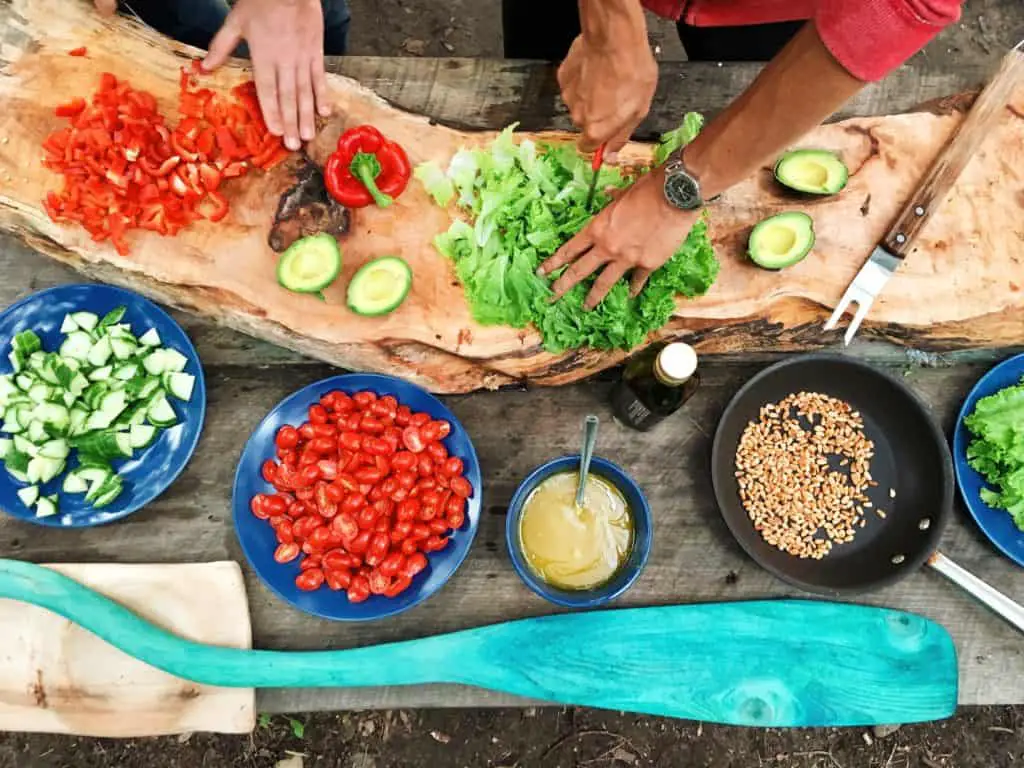
Basic Cooking skills that everyone should know
A few basic cooking skills are essential for success in the kitchen, no matter your experience level.
Everyone starts somewhere. If you’re just starting out on your cooking journey, welcome! Cheers to you for taking the initiative and for trying something new.
You may have already mastered some of these skills, but others may be completely new to you. Try not to be intimidated and understand that it’s not always going to be pretty! My first time peeling potatoes was a hot mess and my family teases me about it to this day lol. (Thanks mom and grandma)
The great thing is you can keep trying again and again, learning a little something about cooking each time.
Why it’s important to learn new cooking skills
When I first started cooking, it seemed like most recipes I tried out included a task or two that I hadn’t yet fully grasped. I’d then scour the internet for step-by-step instructions detailing exactly what I needed to do.
This took SO much more of my time and energy and really frustrated me.
Occasionally I could give it my best shot and find a way to turn a few meals around! But those were few and far between. Most often I resorted to a quick and easy box-meal rather than trying my hand at something new and refining my cooking skills
I want you to be encouraged to try new recipes and not be intimidated like I was. Take some time to practice these skills and be confident! You got this!
How to Get Started Cooking At home
There are a few key tools you’ll need to get started cooking at home.

- An orderly kitchen is number one! Clutter will only lead to more stress later on. Bare counters and organized cabinets will help you maintain a clear, open mind.
- Have this post handy and easy to reference while you’re hard at work! If you ever have any questions, reach out to me and I’ll do my best to assist 🙂
- As far as cookware goes, it’s best to start with the following items at the minimum. You can find these items at most discount stores or grocery stores. I would, however, highly recommend a quality cutting knife for your safety.
- cutting board for meat
- cutting board for everything else
- cutting knife
- pan
- pot
- sheet pan
- various stirrers
how to teach yourself the basics of cooking
Start simple! As eager as you may be to jump right in and make Baked Alaska or Coq Au Vin, it may be in your best interest to start with something simpler. You don’t have to make a “fancy” meal to be considered a “real” cook. Every recipe you make is an accomplishment!
Be patient with yourself and set aside plenty of time as you’re learning. For me, that means trying out a new technique in the middle of the afternoon and not at dinnertime when I’m starting to get a little hangry and easily frustrated.
Fine tune your skills through lots of practice, one piece at a time. It doesn’t even have to be a full recipe! Eventually I absolutely want you to reach that point of seamlessly preparing an entire meal for your family, but for now let’s focus on moving slow and steady.
Whenever you have an hour or two of free time, pick an item from the list and set a goal for yourself. Create a marinade that you could use later in the week, or chop a few veggies for a light snack or as prep for a later meal. There’s no pressure if it’s just for fun right??
Lastly, there’s no shame in ordering a pizza! We all make mistakes and sometimes that dish you worked so hard on just may not turn out like you had hoped. If you’re having a night where you’re frustrated and just wanna throw in the towel, treat yourself to a nice glass of wine and ordering in. There’s always tomorrow.
21 basic cooking skills
As we start this series together I will elaborate on each cooking skill one-by-one with a post devoted entirely to each skill. The beginning of the week will be an indepth look at the technique, and the end of the week will be a recipe to test your skills!
Menu
- 1. How To Read A Recipe
- 2. Knife Skills
- 3. Food Safety
- 4. Four Elements Of Cooking: Salt, Fat, Acid, Heat
- 5. Sautéing Veggies
- 6. Roasting Veggies
- 7. Marinating Meat
- 8. Sautéing Meat
- 9. Roasting Meat
- 10. Making A Roux
- 11. Making A Sauce
- 12. Making Homemade Broth
- 13. Making Soup
- 14. How To Use Herbs And Spices
- 15. Boiling Potatoes
- 16. Cooking Pasta
- 17. Cooking Rice
- 18. Cooking Eggs
- 19. Baking A Potato
- 20. Time Savers: One-Pan And Sheet Pan Meals
- 21. Prepping Meals
1. How to read a recipe
- Read the ENTIRE recipe. At least once, maybe 2 or 3 times to be safe. This will save you time and prevent future headaches. Read the recipe thoroughly from beginning to end, noting the ingredients used and the equipment that’s needed.
- Pay attention to the order of the steps to see where to begin. Should the oven be preheating? Should butter be warming to room temperature? Everything should be clearly laid out to you in the instructions.
- Be aware of the specific words used throughout the recipe and always look something up if you’re unsure. “Sliced” and “diced” mean very different things!
Read the full post HERE!
2. Knife skills
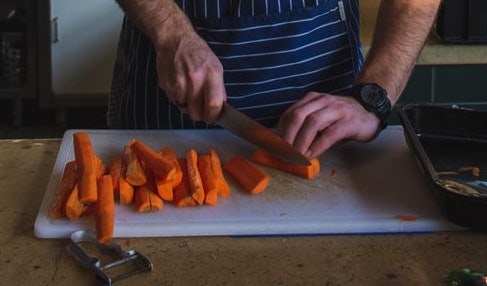
- It’s extremely important to practice safe knife skills to prevent any injury. To hold the knife, wrap your fingers around the handle and hold the top of the knife between your thumb and forefinger. This gives you a firm grip and more control when you’re chopping.
- When chopping food, try not to lay your other hand out flat. Rather, curve your fingers inward like a claw to hold what you are chopping. Your knuckles can help guide your knife and you’re protecting your fingertips.
- Cuts are made from the front of the knife to the back in a gliding motion. Holding and chopping properly will take some time and lots of practice!
Read the full post HERE!
3. Food Safety
- Safety is of paramount importance when cooking. The CDC has tremendous resources that I would encourage you to read thoroughly and refer to if you ever are unsure about what is and isn’t safe.
- Their four steps of food safety are: clean, separate, cook, chill. Clean your hands, surfaces, and tools frequently. Keep raw meat separate from other food. Cook food to the proper temperature. Chill perishable food quickly.
Read the full post HERE!
4. Four Elements of Cooking: Salt, Fat, Acid, Heat
- Salt – enhances flavor
- Fat – delivers flavor and generates texture
- Acid – balances flavor
- Heat – determines the texture of food
- Understanding the four elements of cooking will assuredly elevate your cooking to the next level. Samin Nosrat is a world-renowned chef and has an superb New York Times Bestselling, James Beard Award-winning cookbook titled Salt, Fat, Acid, Heat: Mastering the Elements of Good Cooking. On her website, Ciao Samin, you can find her amazing resources that she’s created. Also I would 100% recommend checking out the Netflix documentary inspired by the book. You’ll fall in love with Samin just like I did!
- All of this information was pulled directly from her site and book, there is no doubt she is the professional and I am just the conduit. I have a lot to learn from her!
Read the full post HERE!
5. Sautéing veggies
- Sauteing is type of cooking over medium high heat with a little bit of oil or butter and involves lots of stirring of vegetables. This technique works best when the vegetables are chopped into bite-size pieces and are about the same size.
- Add the oil to the pan and start with the more dense vegetables that take longer to cooker. Then after a few minutes of cooking start adding in other vegetables that require less time.
- The vegetables can be sprinkled with seasoning, tossed in a sauce, and served as a fantastic dinner side.
Read the full post HERE!
6. Roasting Veggies
- Prep a large sheet pan, lining with aluminum foil and spritzing with olive oil (my favorite olive oil sprayer is a game changer). The pan should be large enough to allow space between the vegetables.
- Preheating the oven to 400 degrees is generally the best temperature for veggie roasting.
- Chop the vegetables into even bite-sized pieces. Generously toss in olive oil for full coverage and sprinkle on salt and pepper. Add any of your favorite seasonings too!
- Just like with sauteing, denser vegetables require more time to roast than thin vegetables (think 30-45 minutes compared to 10-20). Bake until the veggies are lightly browned or can be easily pierced with a fork.
Read the full post HERE!
7. Marinating Meat
- A great marinade will add immense flavor and tenderize meat.
- Most marinades contain an acid (citrus, vinegar, wine), a lot of fat (oils, yogurt), salt (sea salt, soy sauce), and seasoning.
- There are endless combinations of seasonings and spices to use depending on the type of meal you are making. Think garlic, herbs, and peppers.
- Another key factor to a good marinade is time. Meat really needs to sit in the marinade to allow the flavors to transfer and the meat to become tender. At the minimum, 30 minutes will do the trick but if you can plan ahead enough, overnight is great.
Read the full post HERE!
8. Sautéing Meat
- Sauteing is a quick, tasty way to prepare meat.
- Pat the meat dry with a paper towel to allow for it to brown easier. Cut the meat into smaller pieces if you prefer, and season liberally. (Luke has found that he would much rather cut chicken into strips or pieces rather than sauteing whole pieces. Doing so gives you more control over the cooking process, and the pieces that need more time to cook can remain in the pan while the done pieces can be removed. Steak and shrimp saute better whole, while chicken and pork tend to be a little tricker to ensure full doneness)
- Pour enough oil to cover the bottom of a hot pan. Add the meat to the pan without any layering, allowing some room between the pieces. Once that side of the meat is nicely browned, flip to the other side.
Read the full post HERE!
9. Roasting Meat
- Roasting is best for cooking large pieces of meat. Depending on the type of meat, the roast can be low and slow or fast and high Carefully read the recipe for specifics.
- Before cooking, the meat should sit out from the fridge and brought up to room temperature.
- A large baking dish or roast pan is best for even cooking. If you have a baking rack, place the meat on the this for better air-flow.
- Cover the meal with olive oil or better and season generously with salt, pepper, and your favorite seasonings.
- Have a meat thermometer handy to test when the meat is done. There are lots of cooking charts out there that show the proper temperatures for different meats.
- Always allow the meat to rest before serving! It will continue cooking out of the oven.
Read the full post HERE!
10. Making a roux
- A roux is one part flour, one part oil. It is a thickening agent used in lots of sauces to, you guessed it, thicken a sauce naturally.
- Start by heating butter or a cooking oil and then add the flour. Stir often to avoid burning. A white roux is ready after just a few minutes! Continuing cooking longer for a darker brown roux.
- If the liquid in your dish is hot, room temperature roux can be added to the liquid, stirring vigorously. If your liquid is cold, the liquid should be added to the hot roux, stirring vigorously.
Read the full post HERE!
11. Making a Sauce
- A sauce is a easy way to introduce extra flavor to a meal. They can be so easy to make too!
- There are 5 “mother sauces,” or basic sauces, that are starting points for endless other sauces. 2 of them will probably be used more often than others: bechamel and tomato sauce.
- Bechamel, a base for cream sauces, consists of heating milk or cream and thickening with a roux. Cheese can then be melted in for a nice creamy sauce over pasta.
- For a simple tomato sauce, saute onions and garlic and then add LOTS of canned tomatoes and simmer. Use this base to create incredible Italian or Spanish red sauces.
Read the full post HERE!
12. Making Homemade Broth
- You can create your own broths at home that are packed with with nutrients and light on the sodium.
- Clean out your kitchen and grab any remaining herbs, a variety of spices, and leftover vegetable and chicken scraps.
- Add everything to a large pot filled with water until completely covered. Simmer for a few hours and then remove any bones or vegetable chunks.
- Stock will last a week in the fridge and months in the freezer.
Read the full post HERE!
13. Making Soup From Scratch
- A basic soup consists of 4 parts: a base, meat, vegetables, and seasonings.
- Base: broth or stock (maybe the stock you just created 😉 )
- Meat: chicken, ground meat, or keep it vegetarian
- Vegetables: celery, onions, carrots, garlic are foundations for most soups. You can add anything you have available! Mushrooms, beans, and peppers are my favorites.
- Seasoning: salt, pepper, and a bay leaf are standard. For unique flavors use mixes of basil, oregano, thyme, chili powder, and more!
- Soup can be made on the stove in a large pot or, my favorite, all day in a crockpot.
Read the full post HERE!
14. Seasoning With Herbs and Spices
- Herbs and spices are what really make our dishes pop with flavor. They can be either dried or fresh.
- Dried herbs and spices need time to cook into a meal. Fresh herbs and spices should generally be added towards the end of a meal, and you only need about half of the amount as compared to dried.
- Various combinations of herbs and spices can be used to create unique flavor profiles of different cuisines.
- Keep it simple, using 2-3 herbs and/or spices per dish. There are amazing store-bought spice blends that are tried and true combinations and taste great together: Italian seasoning, Cajun, garam masala, and Chinese five spice.
Read the full post HERE!
15. Boiling Potatoes
- Boiling potatoes is a simple, delicious way of preparing potatoes for a potatoe salad or for mashed potatoes.
- Potatoes can be boiled whole or cubed, with the skins on or peeled.
- I prefer cubed when using sweet potatoes that are very large to allow for even cooking.
- The skins are packed with nutrients so I tend to leave the skins on (and it’s less work than having to peel them).
- Clean the potatoes under water and remove any bad spots. Transfer to a large pot and fill with enough water to cover. Boil and check for doneness every 5 minutes – most potatoes should be done after 10-20 minutes.
- Boiled potatoes are done when they can be easily pierced with a fork.
Read the full post HERE!
16. Cooking pasta
- Cooking pasta is as easy as boiling potatoes. You just need some hot water and you’re all set!
- Use a large pot with lots of water to allow the pasta to move around and not stick together when cooking.
- Salt the water generously. If you feel like it’s too much salt, you’re doing it fine. At least 1-2 tablespoons of salt are necessary to bring out the flavor in the pasta.
- Add pasta to boiling water. If it doesn’t fit in the pan immediately, it will after it softens while cooking. Once the water reaches a rapid boil turn the heat off but leave the pot on the burner. The water will remain hot enough to cook the pasta.
- Add a splash of olive oil and stir often to prevent sticking.
- Al dente means tender, but firm. The only way to know when pasta is al dente and done cooking is to taste it for it’s texture!
Read the full post HERE!
17. Cooking Rice
For a super easy instant pot rice recipe check out this recent post.
- Preparing white rice on the stove takes a cup of rice, water, and a cooking pot.
- First, using a strainer rinse your rice under water to remove any starch residue.
- Bring 1 1/2 cups of water to a boil. Add the rice, and salt and butter if using.
- Turn down the heat and cover, simmering for 18 minutes. The rice should absorb all of the water in the pan.
- Rice is ready when there are steam holes all acroos the top. Fluff with a fork and serve!
Read the full post HERE!
18. Cooking Eggs
- Crack an egg
- The goal when cracking an egg is to make one single, firm tap on the edge of a bowl/pan/counter. Press your thumbs into the crack and gently pull apart, sliding the egg out.
- I recommend cracking the egg in a separate bowl from the rest of the recipe in case there are shell pieces to fish out. At least until you feel comfortable doing so!
- Scramble an egg
- Crack an egg into a bowl. Add a splash of milk, a sprinkle of cheese, and some salt and pepper.
- Melt butter over medium heat. Pour in the egg mixture. As the egg cooks begin lifting and folding the egg until there is no more liquid egg.
- Hard boil an egg
- Cover eggs with cold water in a cooking pot.
- Bring the water up to a full rolling boil. After it reaches a boil turn the heat off, cover, and let sit on the burner for 10-12 minutes.
- It may take some trial and error to figure out how much time is needed to cook the eggs to your preferred texture using your stove and cookware.
- Cool the eggs with cold water and peel.
Read the full post HERE!
19. Baking a potato
- Heat your oven to 425 degrees.
- Pierce the potatoes all over with a fork. Rub with olive oil and add a sprinkle of salt.
- Place directly on your oven rack or use a baking rack placed on a sheet pan.
- Bake 45-60 minutes. The potato will be finished when it can be easily pierced with a fork, or reaches an internal temperature of 200 degrees.
Read the full post HERE!
20. Time savers: one-Pan and Sheet Pan Meals
- An essential skill to learn is the brilliance of one-pan and sheet pan meals. You’ll thank me when it’s dinnertime and you’re starting to get a little hangry 😉
- The beauty of one-pan meals is the ease of the recipe and practically no cleanup afterwards. There may be lots of prep to chop veggies and meat, but the pay off is worth as you just throw in the ingredients and let it cook!
- Sheet pan recipes are amazing because all of the food can roast together in the oven with the flavors mixing in together. They’re even more hands off than one-pan meals because you can put them in the oven and not check on them until they’re almost done. AND there’s quick cleanup!
- Time-saving meals will quickly work their way into your routine, allowing you to craft delicious meals in no time. Find some ideas on Pinterest or make your own!
Read the full post HERE!
21. Prepping Meals
- Meal prep is a hidden gem of the food world. When I initially learned of meal prep I associated it with calorie-counting, food-weighing, and the same boring food everyday. 3 things I want nothing to do with
- I’ve learned that incorporating a little bit of meal prep into your weekend routine can save you loads of time during the busy workweek!
- I don’t meal prep dinner, but each weekend I prepare a delicious breakfast for the week that I wouldn’t have time to make in the mornings before work, and a healthy, savory lunch to take to work to avoid eating out.
- Breakfast involves egg cups, baked oatmeal, or (my favorite) zucchini fritters. Rotating these options helps me from never being tired of these foods.
- Lunch consists of a meal that I can make A LOT of in order to have 4-5 meals. This means soups, stews, crockpot meals, and sheet pan meals, stuffed with vegetables and lots of nutrients.
- Find what works for you and see what meals will get you excited throughout the week! Meal prep should be fun and does not have to be boring or feel like a chore.
Read the full post HERE!
How to master basic cooking skills
Practice, practice, practice!
Be patient with yourself and take a little bit of time to fine tune these skills one at a time. Start small and take everything one step at a time. Before you know it, you’ll be making meals like a pro and will most importantly, feel comfortable and confident in your kitchen.
So, where do you go from here? As I did, begin trying out your newly learned cooking skills with some fun recipes!
As we start this series together, I will elaborate on each cooking skill with a new post devoted entirely to each one. The beginning of the week will be an indepth look at the technique, and the end of the week will be a recipe to test your skills!
Pin me!
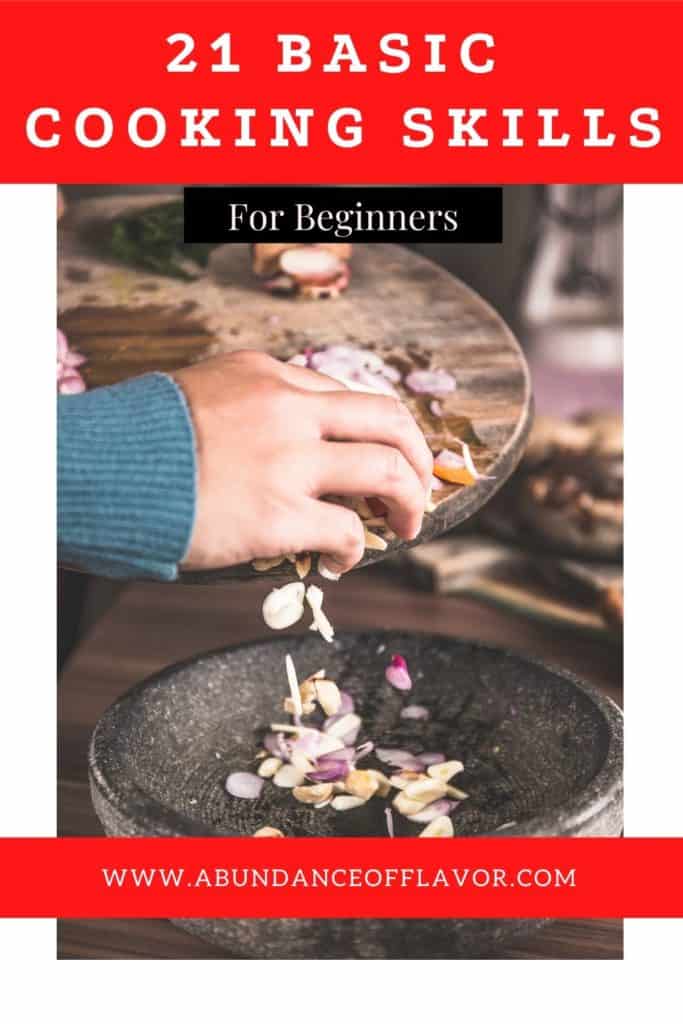

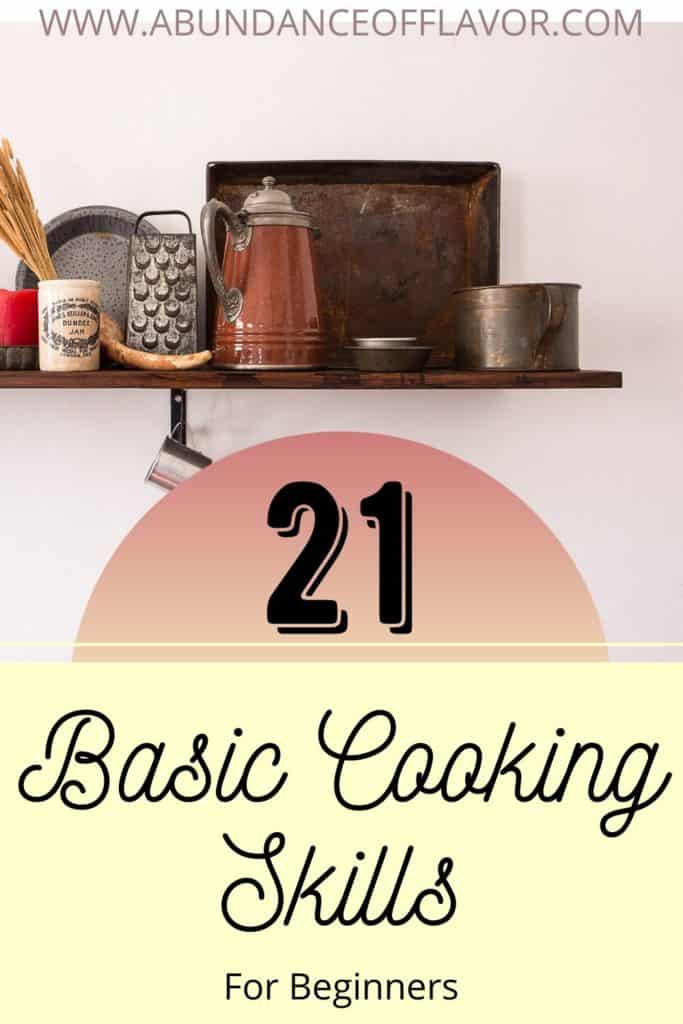
I encourage you to pick 1 or 2 skills to work on over the next week. Whether it be for practice or for a larger recipe, I want you to own it and give it your best shot! Comment below on which recipes you’re hoping to tackle!



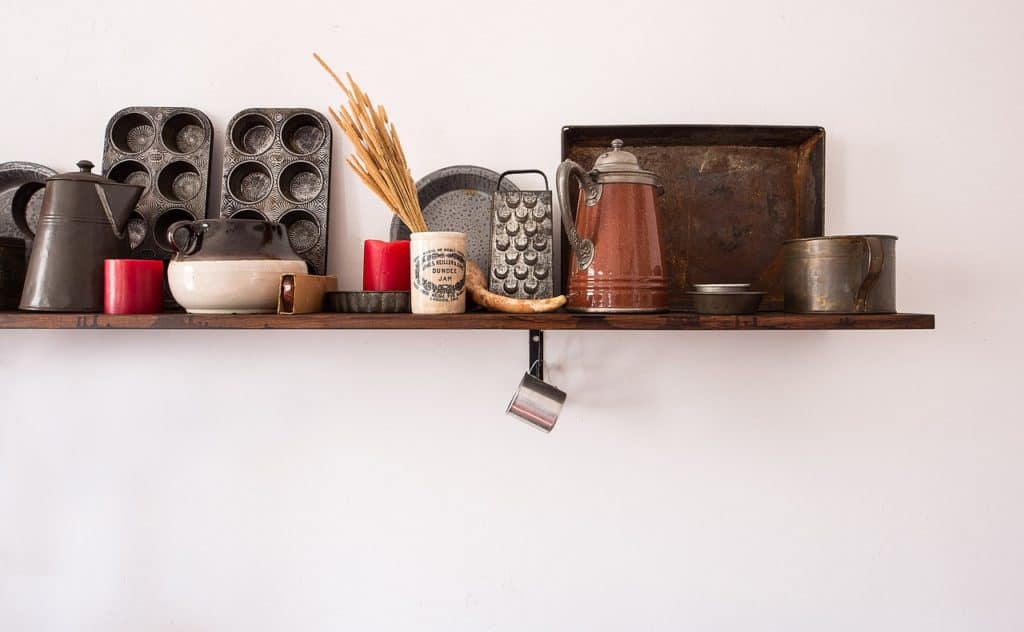
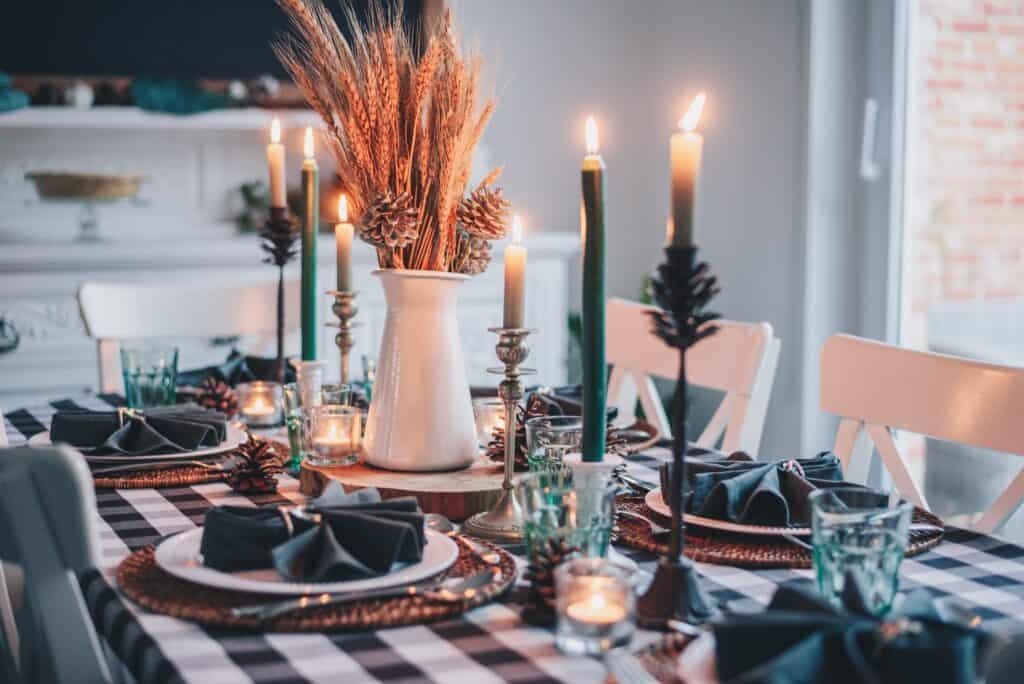
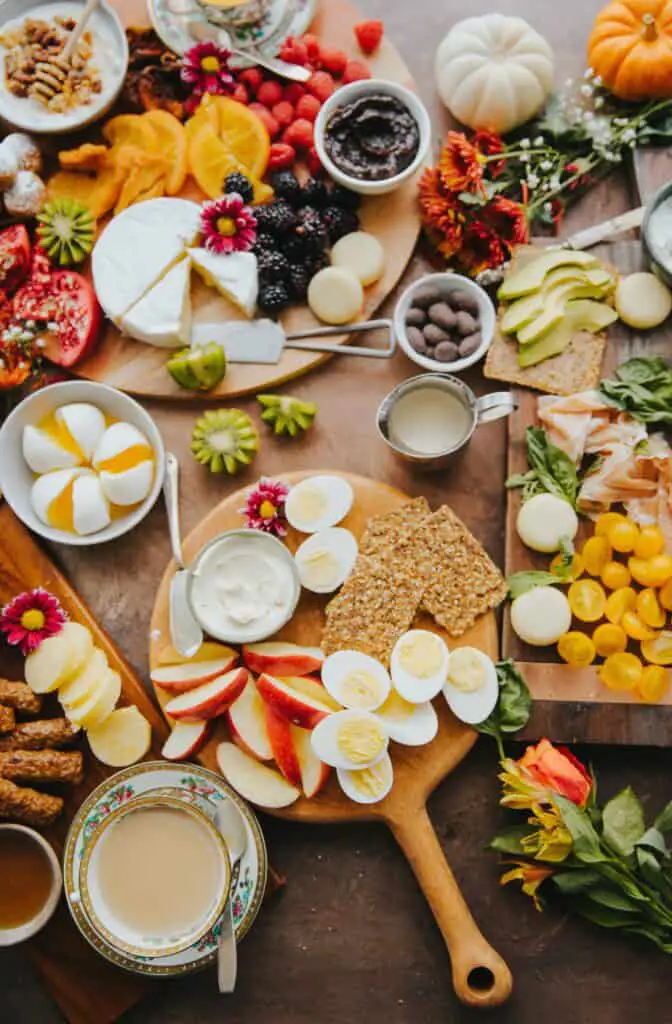

Some really fab tips here, thank you for sharing!
Thanks for your feedback! I hope they are useful 🙂
Great tips! Even if we have some time already cooking we are stealing you some of these tips!! Amazing post!
Thank you so much for your comment! I hope the tips come in handy 🙂
I need these skills 🙂 I have started learning how to cook. Will definitely save this post
Great to hear, and good luck with everything!
There is so much great information in here. I’m not good at roasting vegetables… they never seem to turn out how I hoped when I started. So, I’m going to give the tips in here a try and see if that helps me. Thank you.
Your cooking tips section of the blog is great, packed with useful suggestions even for seasoned cooks! Excellent work!
Absolutely enjoy this series. Thanks!
Some really fab tips here, thank you for sharing!
I am great cook for myself but when guests enter (
1.a. Learn how to logically write a recipe! Ingredients listed in order of use. Instructions in order of progression! NOTES!!! Then if you dare, nutrition.